
Another Lincoln? You bet! I spied this ’70s executive yacht last week on FB. As you know I’m interested in everything Brougham, so had to save the pictures. This particular ’76 looks especially nice in triple blue. And the interior has more square footage than some ‘efficiency’ apartments in the bigger cities…
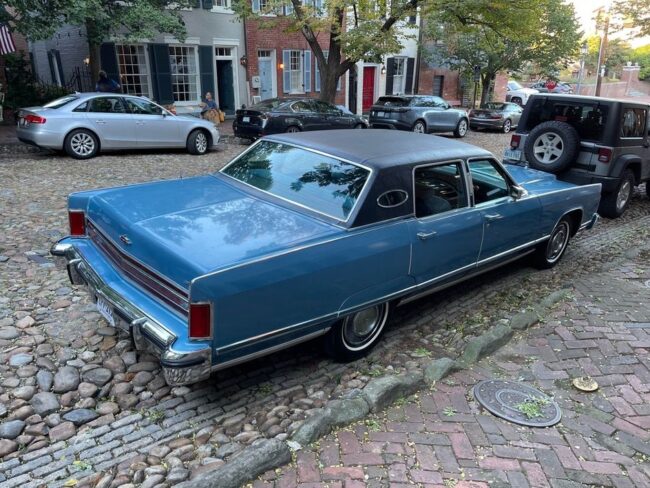
I also had to hand it to the seller for taking attractive pictures. Let’s face it, most CL and Marketplace ads suck. Horrible pictures, no text, etc. And how do so many people find it so difficult to turn their cell phones to the side so as not to have their pictures look stupid? But I digress.
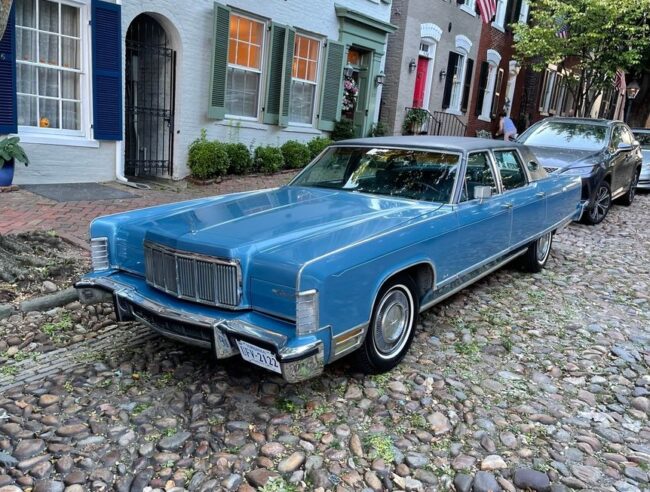
The text from the sale ad was short and sweet: “Up for sale 1976 Lincoln town car runs and drives awesome car needs nothing garage kept all its life. Please, serious inquires only no lowballs. I am located in Falls Church Virginia.”

But the car itself looks spectacular. I love the blue, and especially the blue velour, which looks pristine. And the $8500 ask seems more than reasonable, assuming your garage has the capacity to contain a car this long.

I also love the optional vaned “Luxury” wheel covers. UPDATE: She sold! Guess the ask was pretty enticing for someone.
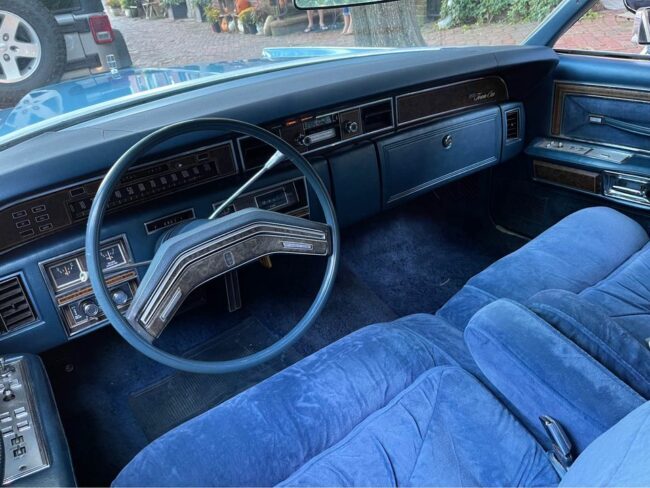
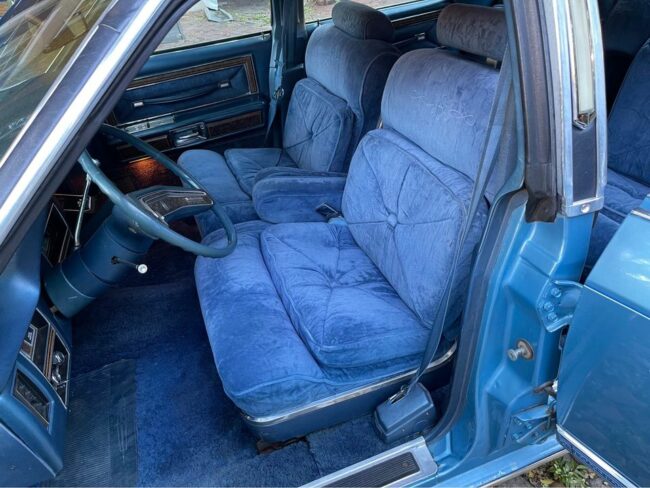
Just a really nice ’70s Lincoln, for those who remember when Lincoln and Cadillac made gilded Pullman cars…
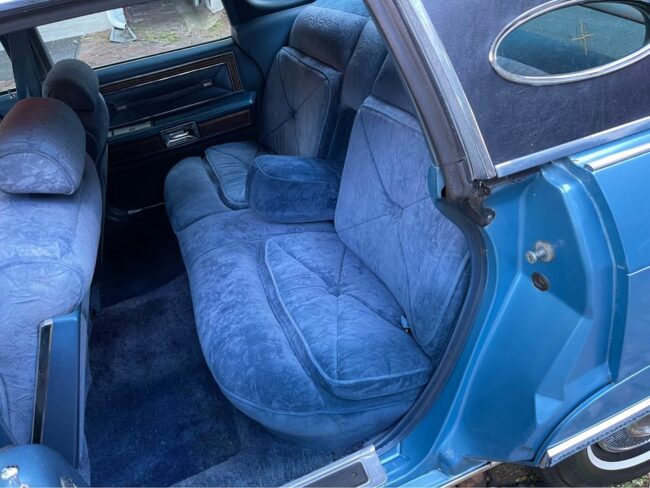
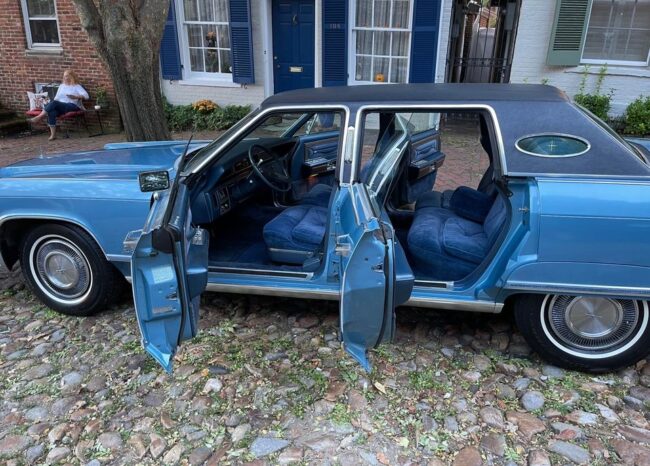







30 Comments
I know you don’t pay attention to engines, but the air filter on this car would have changed its character quite a bit. It is probably indicative that the car sat while gasohol ruined the carburetor and the easiest way to get it running again was to slap on a cheap Edelbrock ‘Performer’ carburetor that didn’t fit the original baffled air filter housing. The car is still in lovely condition, but good luck to the new owner in getting rid of the intake honk that will make it sound more like a teenagers Camaro than an octogenarian’s rolling living room.
Yeah, somewhere, a guy with a ’77 Camaro with traction bars is wondering who swiped his air cleaner…
So many memories of these. My first car, a hand me down, compared to the first one I bought for my own money, was a 1976 Lincoln Town Car. Dark red on red leather. And I need to say, what a horrible car. My dad had a Buick Electra of the same era, and it was just a dramatically better car in every way. You don’t know fear, until you drove one of these beast in a nasty snow storm. How could a 5000+ lb car, with four aboard, have so little traction at the rear wheels. Add to that steering completely devoid of feel, or any apparent connection to the front wheels, and you end up with truly terrifying experience. By comparison, the Electra Limited was great in the snow. Easy to drive and well planted, giving a feel of great confidence in every way.
Almost 40 years later, I can say with complete confidence , that it was the worst driving car that I have ever owned. How Lincoln sold any, when the big Buicks. Cadillacs and Oldsmobile’s, plus the positively “sporty” feeling Imperials and New Yorkers, drove so much better, I will never understand.
On top of that, it was just idiotically engineered. From a basic driving dynamics perspective, and I don’t mean from a BMW perspective, but rather the ability to do the basic tasks required to perform the task of driving, it did nothing well. Actually, it was dreadful. And even considering the fact that it was a challenging era in automotive engineering, what moron came up with the idea of running vacuum hoses, and this beast had miles of leaky, cracking vacuum hoses, into the interior, and connecting them to the always leaky headlight switch to open and close the headlight doors?
All that being said, I always found them to be gloriously over the top in terms of styling. I prefer the even greater tackiness and tastelessness of the fake Rolls Royce grill that came a year later. Add a set of turbine wheels, and I’m in Big 3 Luxo barge heaven. I was at a local car show this summer, first one in almost 2 years, and spent most of my time talking to, and befriending, the owner of a truly mint 1979 Town Car Collectors Series, in white yet! With all the accessories. It was sensationally, beautifully vulgar.
As vile as that car was to drive, I still find myself looking at the ads for these beasts. I was tempted to pull the trigger on a 1978 460 this past spring from a very long term owner. Knowing that I would not have to use it as a car, but rather could just doddle around aimlessly and annoy Prius and Tesla drivers with the sheer uselessness and wastefulness of it. Only thing that would make it even better would be losing any pretence of practicality and getting the Town Coupe.
I’ve often mulled over retrofitting one with modern suspension components. Not to make it handle in any modern sense, but just to make it reasonably enjoyable to drive. With all the reading I’ve done, I’ve yet to have any confidence that I could pull it off.
Finally, just to prove that a foolish consistency is indeed the hobgoblin of little minds, as much as I hated my Town Car driving and ownership experience, I followed it about 5 years later by purchasing a 1979 Mark V.
I’ve always wondered about the totally lifeless steering and true boat like handling of big Fords and Lincolns of this period, when GM and Chrysler offered a much nicer driving experience. Ford/Lincoln sold boatloads of these things together with equally awful LTDs, Torinos, Gran Marquis, Marks, etc. and I always wondered whether the buyers actually cross-shopped anything else before signing the 4 year note on a ponderous and lifeless Ford Motor Product, or whether there were really hundreds of thousands of Americans who truly did not want to have any idea what the front wheels were doing or to take corners as more than 10 mph without sliding into terminal understeer. The only thing they tended to do better than the competition was block out noise from the outside, and offer more faux Mercedes/Rolls styling cues, which apparently was enough for buyers.
Tom, have you checked out the “Rare Classic Cars” channel on YouTube? A guy based out of Warren, MI has a whole collection of mostly ‘60s and ‘70s Detroit iron in damn near mint condition, with some mighty brougham-tastic Fords in the mix, as well as some “commodity cars” that were probably produced in huge numbers back in the day, and ended up like most would have: he’s got a ‘73 Galaxie 500 hardtop sedan in “detective” black with a dark blue interior, with, IIRC, ** automatic temperature control, ** but not even a radio!
Check it out! He’s even got a couple dinoc-paneled family trucksters in the stable, if memory serves. I think he has at least 20 cars, maybe more.
I remember looking in New England’s WANT ADvertiser, late ’70s/early ’80s – when I was between BMW 2002s – and being smitten by one of these. Also by a triple black Chevelle SS 454 convertible. The asking prices were about equal. Guess which one I regret not buying.
Ditto on vertical smartphone photos. Ixnay!
I was so hoping to open this and see later in the peice Tom’s new continental!
Sorry I got to this party late. This is a nice car especially with the cloth interior in this time when pleather is ubiquitous.
Reading the comments it is interesting how much of the interest in cars like these in their old age is not identifying with the time or the original owner but rather as a display of irony. This example might well have had that type of owner given the carb/intake “upgrade”.
This would not have been the intention of say someone who traffics in say same period 2002s like Patrick. When you think about it though the outcome is the same. Notice the way the 1602s are nowhere in this country despite being the most pure representation of the original design. Notice how few stayed stock but rather got upsized later style wheels and larger Weber carbs or even bogus backward turbo writing on the front clip. When they were done, did they get the car they imagined or just more respect for the original Lincoln or BMW engineer?
I am also looking forward to Tom writing up his new Lincoln, Guessing 2nd gen MKZ? If we are super lucky perhaps also a wrap up on the departed Town Car.
I suspect that cars such as the 2002 get modified because they are owned by real enthusiasts with mechanical aptitude and/or who drive their vehicles aggressively (track days, stop-light GPs, gymkhana, etc.), which are generally not attributes associated with luxury car buyers. I also suspect that among US cars you will see much more owner mods for Mustangs, Corvettes, Camaros, Challengers, Corvairs, GTOs, etc. than with Lincolns, Cadillacs, Electras, and Imperials, just as I expect that 7 series BMW buyers are less likely to mod their cars than 3 series buyers.
I too look forward to hearing the details about Tom’s new ride.
The reason that you don’t see 1600-2s is that they were only really excellent in 1967. The regulations introduced for 1968 greatly limited performance and the 2002 was the answer, which stuck around for five years after the emissions-strangled 1600-2 left the market. There were no 1968 Alfa-Romeos in the US, and it was the end of the road for cars like the Austin-Healey 3000 and Mini Cooper. Sticking BMW’s ‘big’ four in their small two-door allowed them to maintain performance, so the 1600 fell from popularity here.
BMWs were fun to drive. Continentals were fun to ride in. That’s why BMW were often modified to improve their performance, while Continentals were often parked until their carburetors were killed by E10. Did this car get a random four barrel and an air filter that fit it because some hipster doofus thought he’d wake up the 460? Or did it happen because someone just wanted to advertise it as running and driving?
When the really big Lincolns were current, there were plenty that thought they got better every year adding the designer packages and outlasting the mega sized domestic competition. Yet today many come at it with the idea of creating some pimptastic hot rod and bomb around the South like a “freedom riding” commie seeking blues players. Seem to remember even Jack doing that, apparently forgetting the commie part of the whole endeavor. Hardly what the car was meant to do
It seems you agree with me that the first 1602 were best, and indeed none will say the 76 2002 was best as most developed. Yet if you look at the mix and match restorations, you will see much more 76 than 67 and the choices were not made for a gymkhana or even informal hill climbs but more like the dream of a date with cocaine Katie and the hope she will embroidery on your jeans.
Really similar cases of scary modern bodging of worthy artifacts
I owned a 1976 BMW 2002 for 10 years and the reason you see a lot more of them around than the 1967 models is because they are 10 years newer and because BMW was selling a lot more cars in 1976 than in 1967. I also believe the original US 2002 in 1968 had about 100 horsepower, while my 1976 model had 96 – care to compare any Lincoln (or Mustang/Camaro) power ratings between 1968 and 1976 to see how well they maintained power in the face of tougher emission standards?
Clearly BMW did a good job with it, when was the last Glas BMW or Erkel’s bubble BMW anyone saw. Did you keep yours stock, or like the modern BMW and Lincoln people I describe above do you try to turn it modern and thus more ironic?
Mine stayed stock right down to 165-80-13 radial tires and Blaupunkt AM/FM radio. The only mod I ever considered was a 5 speed conversion to get overdrive versus the stock 4 speed, but even spinning at 4,000 at 70 mph I still got 30 mpg on regular gas even when fully loaded.
Same tire size as my first car, a Turismo 2.2. I bet yours got a better performance tire than the Goodyear Vectors on mine.
30MPg at 70 was pretty good, makes me wonder even more what the low compression but free breathing and economy geared 1502 could do.
Thoughtful responses from John C., stingray65 and CJinSD.
In retrospect I probably wouldn’t have actually bought the ’76 Town Car or the ’70 454 Chevelle, although I did have an appointment to see a Boss 302 until the seller cancelled because his engine spun a bearing. Back in the late ’60s and early ’70s my taste in cars swung wildly. And although I sound like a spoiled brat when I talk about my new ’69 Dodge Dart GTS 340 followed by my new ’71 2002, the truth is that neither of my parents drove and, as a car nut since birth, I convinced them that we needed a “family car” when I turned sixteen. I consider myself very fortunate to have had that experience.
As to which year ’02 was the best, when I visited Foreign Engine Company in Everett, Massachusetts for a test drive in 1971, their demo was actually a 1600. Both models sat side-by-side in the showroom, differing only in price by a couple of hundred dollars and in power by eighteen SAE gross. In stock form they were otherwise identical. Later, when I was spending my own money, my five-year-old ’73 2002 – in the same Colorado orange as my first – displayed far better build quality than my ’71. With the ’74 facelift, word at the time had it that fit and finish plummeted as BMWs caught on in the US and production volumes soared. It was understood that model year ’73 enjoyed the peak combination of performance and reliability.
Between my first and second 2002s I owned a ’76 VW Scirocco and a ’70 Trans Am / Ram Air III / four-speed Hurst, in that order. I was always searching for a then-elusive handling / power balance, which was why I chose the smaller, lighter, unibody Dart over a larger, BOF muscle car like a Pontiac GTO in the first place.
After my second 2002 I owned a ’80 VW Jetta and then a ’68 1600 – which by then was a twelve-year-old, rust-free but battered California example – before buying a new ’85 Scirocco for my long commute. Etc., etc., etc.
As much as I love my current E46 325i I’m having a hankering for more power again so we’ll see what happens next.
Interesting cars and commentary especially all the circle backs to previous experiences. Though we didn’t get it in USA there was an interesting circle back after the 3 series was out in Germany. A cheaper, far lighter and post Yom Kippor, more economical 1502, though still with a 1573. Back to basics with the same weight advantage the first 1600 had over the four door. Maybe the last were the best.
I remember seeing 1502s and 1802s in Europe back in the late ’70s, early ’80s. My recollection is that they had no belt trim, dog dish hubcaps and cloth upholstery. Also, plastic grilles, square taillights and no diving board bumpers. I was always intrigued by them because they were so basic but still true to the BMW ethic. They were also still in production after the first Three Series E21 was introduced.
My recollection is that the 1600 was rated at 96 hp, the 2002 at 114 and the tii at 140, all gross horsepower. Then in 1972 or so ratings went to net while at the same time power declined in real terms due to tightening emissions regs, so reality gets hazy from that point on. And yes, production volume soared once my fellow preppies (antecedents of yuppies) took one drive in my 2002 and immediately traded in their Cougars and Chargers for BMWs and Audis. Volume skyrocketed while quality headed the other way, complicated by new Federal safety and emissions rules, although to this day I can’t understand how Congress thought of big bumpers as safety devices.
My first car was a 1971 Bavaria (9 years old at the time) and after one drive my dad said his next car would be a BMW (and it was). I think rides/drives in my Bavaria and 2002 must have led to about 30 BMW purchases among family and friends, as they were a total revelation in terms of handling, ride, performance, MPG, and build quality.
Volvo marketed 5 mph impact bumpers as safety devices on their cars in Europe, although obviously they weren’t safety devices. Marketing is where it is at though, as evidenced by how late to the game Volvo was to standardize head restraints.
The other cars that had 5 mph impact bumpers in Europe were Porsches. They did it because class warfare was more popular on the continent and in the UK than it was in the US, and Porsche owners welcomed the opportunity to not have their cars damaged every time they left them parallel parked. I believe the big bumpers were optional early in 1974, but such was their popularity that all 911s adopted them by 1975. If there’s a car that doesn’t need extra weight hung off its back end, you’d think it would be the 911, but I guess the short hood gave the bumper cars a newer look than the early models that could be seen smoking and rusting.
Remember Volvo had to do some enlarged bumpers, though I believe aluminum, when the standard hit in 1974, even on the last year 164E, one of my favorites though the big bumpers made it look less British which is what I liked about it.
Patrick,
The five MPH bumpers ie; snow plows on some makes (we are looking at you Chevy and Ford) were not so much a safty device as to prevent insurance claims. If you look at many late 1960 and early 1970 cars (looking at you Bunke Birds) there was very little protection offered by the bumper and the sheet metal. Not like the heavy steel bumpers with Dagmars on Cadillacs and other makes in the 1950’s. Insurance companies and consumers complained to their Congressmen that even in low speed parking lot fender benders thousands of dollars of damage was being done to the front and back of cars. Therefore, Congress and their bureaucrats in the various goverment agencies determined that in the best interest of consumer that they would make the auto manufactures have their product have no damage if hit head on in a 5 MPH accident. The rules went into effect in 1973 for front end damage and 1974 for rear damage. However, one of the things that Congress ignored that there is a 7 to 10 year lead time on automotive design and because the 1973 and 1974 designs had been finalized years earlier the only way for the manufactures to meet the requirements was to put shock absorbers behind larger versions of existing bumpers or huge bumper guards (looking at you British Leland and Chrysler) until new designs came down the pike. That is the Readers Digest version of why 5 MPH bumpers were not safety devices but a method to reduce insurance claimes.
I remember an ad by some insurance institute that rammed a Model A Ford and a then new 1969-70 Ford LTD into a barrier at low speed (less than 5 mph) to demonstrate the regression in bumper protection. The Model A sustained virtually no damage and the new Ford had hundreds of dollars worth of damage.
I always thought it was interesting that a tiny Porsche was better able to nicely integrate the 5 mph bumpers into their sleek sports cars than most other far larger car makers were able to do with theirs. GM also did a pretty nice job with making a nice looking 5 mph bumper on their relatively low volume Corvette (and later Monza), and I was never able to understand why the largest auto maker in the world did such a comparatively poor job on their bread and butter sedans and coupes.
Remember that the bumper had to sustain no damage hitting something at 5 mph that weighed the same as it did. This car weighed 5400 pounds. Thus the physics really are against in a way they are not for a 2400 pound 911. There was also the substance of doing it in heavy, expensive, chromed steel to match the substance this car conveys. It must have been a heck of a challenge to have imposed on them and just does not fit the crap on the lazy, unsophisticated white, American, engineers that is so often the go to stance of the import fan. Despite lever/guides, it also must have been quite the back breaker for the some might say ape like people on the assembly line. Imposed by the uniparty and left to the big three to figure out how in hell to do that.
Which was fine up to five mph. Above that, repairs were exponentially more costly.
Then Reagan recinded the law and balance was restored to the universe.
Reagan didn’t rescind the law, he merely lowered the standard to 2.5 mph, which the safety zealots heralded as the end of the universe instigated by an uncaring Republican administration.
If you think about it, the sloping, protruding nose of a sports car lends itself better to an integrated bumper than the flat face of the era’s boxy sedans. The second generation F-Body Camaro and Firebird carried it off well too, particularly with the second and third facelifts.
I was being hyperbolic but the reduction to 2.5 mph was a huge drop.
And to be clear, the universe was unaffected.